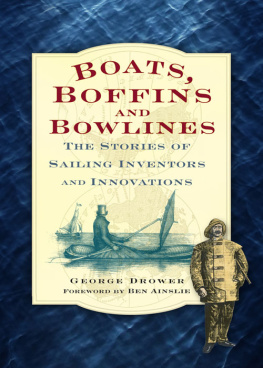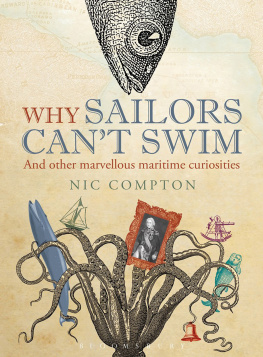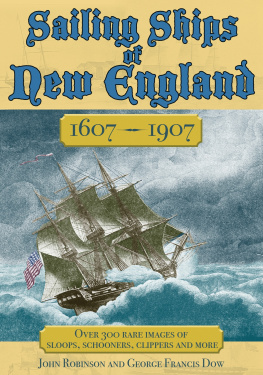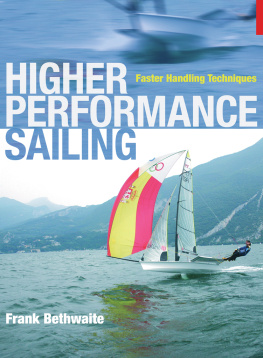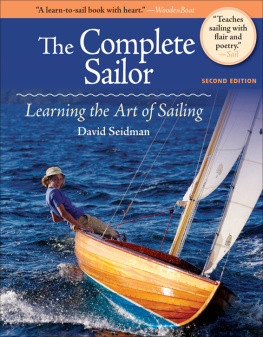C ONTENTS
Nothing is as wonderful as flying along in a sailing boat, whether it has the added frisson of a competitive race or is simply a relaxing Sunday afternoon sail. Having been racing for ten years, I have spent a lot of time messing about in boats, and winning Olympic gold with the Finn was the most glorious moment of my sailing career. Other races, such as the Americas Cup, show how important small aspects of boat design can be in some cases, the difference between winning and losing a race. Thats why I was so fascinated to read George Drowers new book about sailing inventors and innovations. It gave a new insight into the history of my sport, and sailing in general. I was amused to discover that British yacht cruising didnt take off until 1830 for fear of pirates! And that King Charles II was actually of vital importance to my own sport, as he commissioned the building of the first ever English racing yacht. Signal flares, a vital safety feature of any boat, were developed by American Martha Coston, while inflatable boats were invented over a hundred years before they came into widespread use. George Drower has put together a fun and interesting book which has opened my eyes to the boffins who thought of and created the nautical inventions we now take for granted. I hope it will do the same for you.
Ben Ainslie CBE
Yachtsman of the Year 2008
Everyone has heard of the great feats of the worlds circumnavigators, from pioneer Joshua Slocum, who first encircled the globe solo in 18958, to Dame Ellen MacArthur, who became the fastest woman to complete the circumnavigation in 2005, and admired the extraordinary technologically rich racing-fit yachts from celebrity designers such as Nathaniel Herreshoff, Charles Nicholson and Olin Stephens. But what of the boating worlds lesser known inventors and innovators? Their seemingly simple contraptions and ideas have been taken for granted, while they themselves have been ignored. Yet these boffins were the real heroes of sailing. Not only did they provide many of the basic components that made possible the creations of famous-for-being-famous designers; their ingenious devices have contributed greatly to the safety and performance of ordinary yachts.
In unearthing these forgotten pioneers, the circumstances that brought about such changes and the improvements their ideas made, this book makes some astonishing revelations. On every boat, no matter how seemingly mundane, there will be at least a handful of the simplest nautical components from sextants to spinnakers, echo-sounders to steering wheels, signal lamps to anchors that can provide historical stories as fascinating and rich as any associated with luxury yachts. So who were these unsung heroes? How did their ideas come about?
There was the naval engineer John Schank who, needing to devise various means of moving British warships overland to attack rebel forces in lakes during the American War of Independence, thought of a method of enabling boats to manoeuvre in shallow water by equipping them with dagger-boards! When he returned to England, to serve as Dockyard Commissioner at Deptford in the 1790s, he persuaded the Admiralty to build various centreboard ships. The leaks around those dagger-board contraptions caused him to invent the watertight bulkhead; nevertheless the experimental dagger-board was abandoned in England. Its subsequent popularity in America as the centreboard obscured the fact that its originator was British.
Then there was Edward Bentall, the wealthy Essex agricultural implement maker who in 1880 audaciously applied plough technology to sailing, with a radical yacht called Evolution. She was the worlds first boat with a fin keel, but she proved unsuccessful because Bentall had unwittingly made her design too slender. The idea was taken up and developed in Newport, Rhode Island, by Nathaniel Herreshoff in 1891, and thus the fin keel also came to be seen as an American invention.
Some winning ideas occurred through happenstance. In 1837, for example, an experimental steam launch puffing along a canal near the London Docks accidentally clipped an object in the water, which snapped off part of its propeller. Suddenly the boat went faster! This enabled a sheep farmer called Francis Smith, who was carrying out the trials, to modify the propulsion system and gain worldwide credit for inventing the worlds first viable screw propeller. Then there was the story of a young Boston widow who was desperate to find a means to support her four children. In 1848 she perchanced to find, among her late husbands papers, plans to invent a signal flare. The enterprising Martha Coston went on to develop and market that safety device, but she rarely receives recognition for it. Rather unjustly the flares became synonymous with the Very pistol, because in 1877 Lieutenant Edward Very USN invented a firing mechanism for the Coston system.
Some ideas were far ahead of their time. In 1842 Peter Halkett of Richmond-upon-Thames devised the ingenious cloak-boat, a rubber dinghy sewn with the lining of a cloak! It ought to have been presented as a life-saving device but Halkett, who had tested it on rivers and at sea, was keener to promote it as an exploration boat for Arctic expeditions. Nevertheless he envisaged how giant versions of the boat could be used as emergency liferafts able to accommodate some thirty shipwreck victims. But the rapid progress of Halketts career in the Royal Navy meant he never had another chance to develop such a system and the advantages of inflatable boats did not become widely apparent until some hundred years later. Another futuristic device was the azimuth liquid compass, perfected in 1813 by a Kent silversmith called Francis Crow. Although more stable in a boat or yacht than a traditional card compass, Crows invention was unfortunately misfiled by the Admiralty as just a device for expeditions of discovery.
To be successful, even the most audacious boating pioneers needed to have an aptitude for drastic ad hoc innovation. Take Starling Burgess for example, the inventor of the alloy mast on the J-class yacht Enterprise, Harold Vanderbilts defender of the Americas Cup in 1930. During a selection race in rough seas, Enterprises spreaders came adrift and the revolutionary 163ft mast threatened to break. On board, Burgess reacted instantly and ingeniously prevented the collapse by using spinnaker halyards to reinforce the structure thus enabling Enterprise to be selected and ultimately successful in keeping the Cup for America. The worlds first circumnavigating yachtsman, Joshua Slocum, faced calamity during his epic 18958 trip when, crossing the Indian Ocean, the tin alarm clock he used as a chronometer suddenly stopped. He cleverly restarted the timepiece by dunking it in boiling water!
Several of the boating boffins devised more than one invention, and for some the difficulty was that they were just too prolific. Captain George Manby made his name as the inventor of a mortar for firing rescue lines. Unfortunately he did not stop there; instead he bombarded the Admiralty with a wide variety of other schemes, ranging from a device for rescuing persons who had fallen though ice, to a message-kite, an oblong artillery shell and a harpoon gun. So when he offered them his brilliant invention of the fire extinguisher they were too irritated with him to accept it. The Revd Edward Berthon also tested the Admiralty too far with his multiplicity of schemes, which included a hydraulic speedometer (which he called a nautachometer), a propeller and a clinometer. His response when they initially dismissed his scheme for a folding lifeboat was to destroy all the prototypes and move away from the sea. Only many years later was he persuaded to resume the development of the lifeboat.

